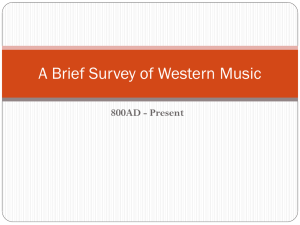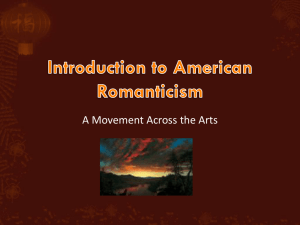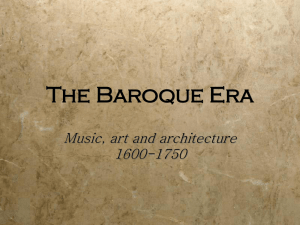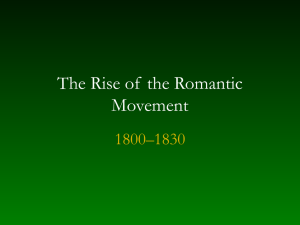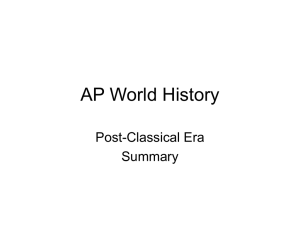Music Curriculum K-12 - Providence Classical School
advertisement
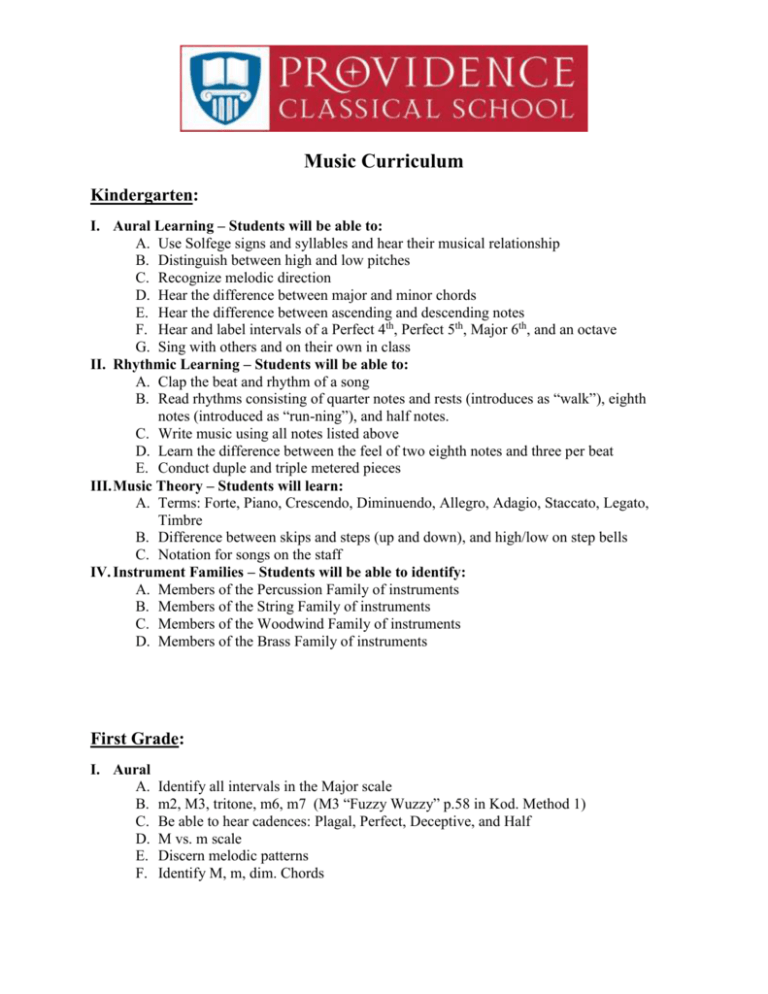
Music Curriculum Kindergarten: I. Aural Learning – Students will be able to: A. Use Solfege signs and syllables and hear their musical relationship B. Distinguish between high and low pitches C. Recognize melodic direction D. Hear the difference between major and minor chords E. Hear the difference between ascending and descending notes F. Hear and label intervals of a Perfect 4th, Perfect 5th, Major 6th, and an octave G. Sing with others and on their own in class II. Rhythmic Learning – Students will be able to: A. Clap the beat and rhythm of a song B. Read rhythms consisting of quarter notes and rests (introduces as “walk”), eighth notes (introduced as “run-ning”), and half notes. C. Write music using all notes listed above D. Learn the difference between the feel of two eighth notes and three per beat E. Conduct duple and triple metered pieces III. Music Theory – Students will learn: A. Terms: Forte, Piano, Crescendo, Diminuendo, Allegro, Adagio, Staccato, Legato, Timbre B. Difference between skips and steps (up and down), and high/low on step bells C. Notation for songs on the staff IV. Instrument Families – Students will be able to identify: A. Members of the Percussion Family of instruments B. Members of the String Family of instruments C. Members of the Woodwind Family of instruments D. Members of the Brass Family of instruments First Grade: I. Aural A. B. C. D. E. F. Identify all intervals in the Major scale m2, M3, tritone, m6, m7 (M3 “Fuzzy Wuzzy” p.58 in Kod. Method 1) Be able to hear cadences: Plagal, Perfect, Deceptive, and Half M vs. m scale Discern melodic patterns Identify M, m, dim. Chords Music Curriculum II. Reading A. Rhythmic 1. Create own rhythmic patterns 2. Tell if beat has two or three parts 3. Read and count rhythm patterns that include 3 and 4 beats per bar, both in single and compound time. 4. q , e, h , h., w , z , half rest, and whole rest 5. “Read ahead” one bar while clapping/counting another four beat bar 6. Visually discern rhythms they hear 7. Count with numbers and know names of notes (quarters) 8. Clap two different ostinato rhythmic patterns in two groups at the same time B. Melodic 1. Read solfege syllables of melodic patterns with moveable Do 2. Play melodic patterns presented on the xylophone 3. Identify how pitches are moving: up/down/repeat; skip/step 4. Sing and/or play on the xylophone combined melodic/rhythmic patterns presented. III. General A. Identify family and specific instrument by sight and sound and seat in orchestra B. Composers/works: Bach, Mozart, Beethoven, Vivaldi, etc. Second Grade: Daily Work: 1. Journal - Students will listen to a piece of music and answer basic music questions ranging from theoretical to personal. I. Unit 1: Rhythm Review A. Echo rhythmic patterns, then read them from notation on the board (sixteenth, eighth, quarter, half, and whole notes with their corresponding rests). B. After reading through some chants (“Poison Ivy”, “Bling, Blang”, “Two, Four, Six, Eight”), students will work in groups to write their own. They will first compose a rhythm, then fit words to the rhythm, breaking up syllables accordingly. Perform for class. II. Unit 2: Introduction to Note Reading A. Introduction to notes on the staff. Practice on the duct tape note twister board on the floor by having kids stand on each line of the staff and say what note they are. B. Using individual white boards in the classroom, review note names individually. C. Work through stories that spell out some words in notes. More individual learning time. Music Curriculum D. Telephone composition: students work in groups at the keyboards to compose simple pieces based on their telephone numbers. This is note name application. III. Unit 3: Putting it all together with Recorders! A. Introduction to the procedures for recorders in music. 1. Rest position, Ready position, Playing position 2. Left hand on top, blow lightly, make sure holes are covered completely 3. Consequence for playing out of turn: loose instrument for 2 minutes B. Begin learning notes and playing pieces. 1. First three notes: BAG 2. When learning a piece: i. Clap and count rhythm ii. Clap and say each note iii. Say each note while fingering on the instrument in “ready” position. iv. Play the piece C. Pieces will vary from year to year, but are based upon song they learned in first grade (“Spring” from Vivaldi’s Four Seasons), pieces they will eventually study in future grades (“William Tell Overture” by Rossini), and basic children’s songs (“Hot Cross Buns”, “Mary Had a Little Lamb”). D. The semester will culminate in a school performance. IV. Unit 4: Knowledge Application through Composition A. Combining knowledge of recorder and music theory basics, students will compose a piece on their recorders. They will learn to critically listen to pieces and suggest changes for their peers. Student will perform. Third Grade: Daily Work: 1. Journal: Students will listen to a piece of music and answer basic music questions ranging from theoretical to personal. 2. Vocabulary: Students will build a vocabulary of musical terms and begin to incorporate them into everyday use. I. Unit 1: Rhythm review A. Read rhythms on board and from chants handed out. B. Compose rhythms as a class and play together on classroom percussion instruments. C. Hand out “Rhythm Band” parts and learn to play on percussion instruments. Rhythm Band uses famous pieces, like Bach’s “Minuet in G”, to help students learn to read Music Curriculum rhythms independently. There are four separate parts students will be assigned in groups to play and they must follow their part and play it while listening to the piece on the piano. II. Unit 2: Rhythmic Composition A. Follow up project to rhythm band: Students will work in pairs to write two different rhythms that they will perform simultaneously on a classroom percussion instrument of their choice. B. Students will learn two basic chords on the guitars, then work in groups to write pieces and perform them for the class. III. Unit 3: Note Reading Review A. Review note names with individual classroom white boards. B. Play note twister C. Play note spelling games (either as whole class, or individually on white boards) D. Individually work through a note reading worksheet so teacher can make sure students grasp the concepts. IV. Unit 4: Recorders A. Students in the 3rd grade play more advanced pieces than when they were in second grade and begin applying their vocabulary words (dynamics, tempo, crescendo, etc.) to being able to play more musically. They will also be expected to take their recorders home to practice and bring them to class every week. Fourth Grade: Daily Work: 1. Journal: Students will listen to a piece of music and answer basic music questions ranging from theoretical to personal. 2. Vocabulary: Students will build a vocabulary of musical terms and begin to incorporate them into everyday use. I. Unit 1: Introduction to music classroom A. Familiarize students with rules and procedures in the music classroom. B. Work out a class definition of music through debate and discussion II. Unit 2: Introduction to Music in the Romantic Era A. Brief introduction to the Romantic Era (take notes on dates, key composers, world events) Music Curriculum B. Apply knowledge of Romantic styles to composition. C. Hand out project guideline that is a review of the notes and listen to Romantic pieces and give examples of work. D. Work together in groups to write piece (2 class periods MAX) and perform for class. Evaluate peer’s work and list how it sounds “romantic”. I. Unit 3: Review music Basics with guitars A. Review basics of music rhythm using white boards to check for understanding (time signatures, note values, etc.) B. Break up into groups and compose 4-bar rhythm in any time signature. C. Intro to guitar – learn parts and care. Learn C and G7 chords and practice playing them to rhythms as a class. D. Teach them how to rehearse together (count off, clap it first, then strum) and practice putting chords with rhythms. Perform for class. II. Unit 4: The Blues A. Listen to and discuss basic form of the blues, including the context in which it was sung and who sang it. B. Be able to recognize the chord changes in a 12 bar blues (watch, listen, identify) C. Learn the basic guitar blues progression. D. Using worksheet as guide, compose a blues piece. E. Compile compositions for the class. Play and sing through them together (with sunglasses, of course!). III. Unit 5: Ragtime A. Students will review history of Ragtime music B. Student will learn a basic music piece on the piano C. Students will learn to improvise a rag and perform in groups. Fifth Grade: Daily Work: 1. Journal: Students will listen to a piece of music and answer basic music questions ranging from theoretical to personal. 2. Vocabulary: Students will build a vocabulary of musical terms and begin to incorporate them into everyday use. I. Unit 1: Introduction to music classroom A. Familiarize students with rules and procedures in the music classroom. B. Work out a class definition of music through debate and discussion Music Curriculum II. Unit 2: Introduction to Music in Ancient Egypt A. List uses of music today and compare them to uses in ancient Egypt B. Listen to and analyze recordings of music reproduced from that time (review uses and discuss instruments, meter, etc.). III. Unit 3: Archeologizing the Past A. Understand how information is obtained about the past and create virtual time capsules for preserving today’s music for the future generations to study. B. Students will analyze artifacts from ancient Egypt and extract information about music during that time (primary source data work). IV. Unit 4: Bringing the Past to the Present A. Students will construct a primary instrument used in ancient times (harp). B. Students will learn about basic musicianship as they play and compose for this instrument (time signature, note reading, meter, harmonic structure, form, etc.) V. Unit 5: Homer: The Harp playing poet A. Students will learn to hear and dictate rhythms from aural listening B. Students will choose a poem and write out the rhythm of it. C. Students will compose a piece in the correct rhythm and perform their poems, accompanying themselves on their harps. Sixth Grade: Daily Work: 3. Journal: Students will listen to a piece of music and answer basic music questions ranging from theoretical to personal. 4. Vocabulary: Students will build a vocabulary of musical terms and begin to incorporate them into everyday use. I. Unit 1: Introduction to music classroom A. Familiarize students with rules and procedures in the music classroom. B. Work out a class definition of music through debate and discussion II. Unit 2: Introduction to Music in the Middle Ages and Gregorian Chants A. Collect class knowledge of the era (what have they learned in history so far?) and teach them the basics they don’t know yet. B. Learn about Pope Gregory and his contributions to music through readings and worksheets. C. Listen to Gregorian chants and see how they were composed. Music Curriculum D. Create a basic system of notation and compose a Gregorian chant from a Latin scripture verse. E. Sing through all the chants and evaluate work. III. Unit 3: Polyphony and Organum A. Learn about Leonin and Perotin and the emergence of polyphony (read and hear). B. Students will learn about intervals and compose Organum over a Gregorian Chant. C. Students will sing through their Organum examples to experience the pull of simultaneous melodies (polyphony). IV. Unit 4: Troubadours, Trouveres, and Jongleurs A. Learn about these three types of musicians and their roles in society (reading) B. Work in groups to write songs in the style of a troubadour or a trouvere. C. Perform for class and evaluate work. V. Unit 5: Transition to the Renaissance A. Review progression of music in the middle ages and take test over their knowledge B. Read about ars antique and ars nova and the transition of music into the next era. C. Learn about Josquin des Prez and his compositions that launched the Renaissance. VI. Unit 6: Musical forms and their composers in the Renaissance A. Study each form and composer in depth (engage in project of some sort) 1. Motet (composer: Gabrieli) 2. Mass (composer: Palestrina) 3. Chanson (composers: Ockeghem and de Lassus) 4. Madrigal (composer: Menteverdi) VII. Unit 7: Knowledge Application through performance A. Students will learn basic instrument technique on renaissance instruments, read music, and learn to play as a group to accompany Renaissance dancing. Seventh Grade: Daily Work: At the beginning of every class, students will listen to a piece of music and answer basic music questions ranging from theoretical to personal. I. Unit 1: Introduction to music classroom A. Familiarize students with rules and procedures in the music classroom. B. Work out a class definition of music through debate and discussion Music Curriculum II. Unit 2: Introduction to Music in the Baroque Era A. Brief introduction to the Baroque Era (take notes on dates, key composers, world events, like William and Mary). B. Learn to dance the Gavotte in order to understand how music was used in the Baroque era and to get a feel for what it sounded like. C. Work through packet on the Baroque Era on own or in groups to learn other basics (music form and structure, more details on main composers, instrumentation, etc.). III. Unit 3: Projects A. Knowledge application through performance: Students will learn basics of guitar and learn to play excerpts of pieces written in the Baroque era. They will apply their knowledge of the era to the performance of each piece. --------or-------B. “A Day in the life of a Baroque Composer” Assign students to groups and give then commissions. They are servants of one master and receive an assignment to compose a piece (piano, guitar, or vocal) for a certain event (3 days/weeks to write). Since we haven’t worked on musical notation yet, they don’t have to write the piece in traditional notation, but must write it down somehow. In future years, I might throw in a music theory unit before this so they can be required to write in standard music notation. Invite a PCS dad to come in and play the part of the lord of the house on performance day. IV. Unit 4: Aural identification of Baroque music A. Teach students how to listen to Baroque music. There are many commonalities: Unity of Mood, Unity of Rhythm, Continuity of Melody, Terraced Dynamics, Walking Bass, and Text Painting. Listen and identify. B. Play examples of Baroque pieces for students and have them fill out worksheet as to what piece best exemplifies each musical aspect of Baroque music (ex: Pachelbel’s Canon in D is a prime example of Walking Bass, Handel’s Messiah is flush with Text Painting, etc.). C. Pass out cds of Baroque pieces for students to learn to identify. D. Begin to work through pieces in depth: composers, dates, specifics about each composition, etc. Practice identification every class period. E. Test students on their grasp of Baroque Era (pieces, critical listening skills, and dialectic application) V. Unit 5: Introduction to Classical Era: A. Introduction to the Classical Era – teacher lecture. Music Curriculum B. C. Learn to dance the Waltz in order to understand the simplicity of music in the Classical era and to get a feel for what it sounded like. Work through packet on the Classical Era on own or in groups to learn other basics (music form and structure, more details on main composers, instrumentation, etc.). VI. Unit 6: Aural identification of Classical music A. Teach students how to listen to Classical music. Focus on its simplicity and use of the piano. B. Play examples of Baroque and Classical pieces for students to discern. They should recognize the ornate melodic lines to be Baroque, while the Classical melodies are sparse and clear. C. Pass out cds of Classical pieces for students to learn to identify. D. Begin to work through pieces in depth: composers, dates, specifics about each composition, etc. Practice identification every class period. E. Test students on their grasp of Classical Era (pieces, critical listening skills, and dialectic application) VII. Unit 7: Knowledge application through performance: Students will work in groups to recreate pieces written by Classical composers. They will apply their knowledge of the era to the performance of each piece. Eighth & Ninth Grade: I. Introduction to music classroom C. Journal: Students will listen to a piece of music and answer basic music questions ranging from theoretical to personal. D. Vocabulary: Students will build a vocabulary of musical terms and begin to incorporate them into everyday use. E. Familiarize students with rules and procedures in the music classroom. F. Work out a class definition of music through debate and discussion II. Introduction to Music in the Romantic Era F. Notes on dates, key composers, and world events G. Music form and structure, more details on main composers, instrumentation, etc. H. Learn to dance the waltz: most popular dance in the Romantic Era and an embodiment of the change of the culture. This “scandalous” dance became most popular at the start of the Romantic era. I. Read article and answer questions (from Mark Ammons book) J. Listen to examples of Romantic music and discuss what makes them Romantic. III. Review music Basics Music Curriculum C. Review basics of music rhythm using white boards to check for understanding (time signatures, note values, etc.) D. Review basics of music notation using duct tape note twister and note spelling game to check for understanding. IV. Applying Knowledge of the Romantic Era D. Review the characterizations of Romantic music and assign composition: specifically the use of folk songs in symphonies. E. Pass out folk songs for students to choose and then discuss how a Romantic composer would change them based upon listening examples (Saint-Saens, Dvorak, etc.). F. Students learn folk songs on instrument (guitar or piano) and then romanticize them (speed up, slow down, expressive dynamics, major/minor switch, change the mood, add notes, etc.) V. Introduction to Modern Era A. Discuss innovation that would change music in the 1900s. B. Read article on Schonberg from the Mark Ammons book and listen to “Survivor in Warsaw” – discuss how 12 tone compositions can be more emotional. VI. Serialism A. Teach students about tonality and chromatics and introduce 12 tone composition B. Hand out project details and begin working on tone row. Create a tone row matrix. Work in pairs. Apply variations to it: retrograde, inversion, retrograde inversion, transposition, and tone clusters. C. Practice on pianos and perform. VII. Soundtracks VIII. Creating Instruments out of everyday objects: STOMP in the classroom


